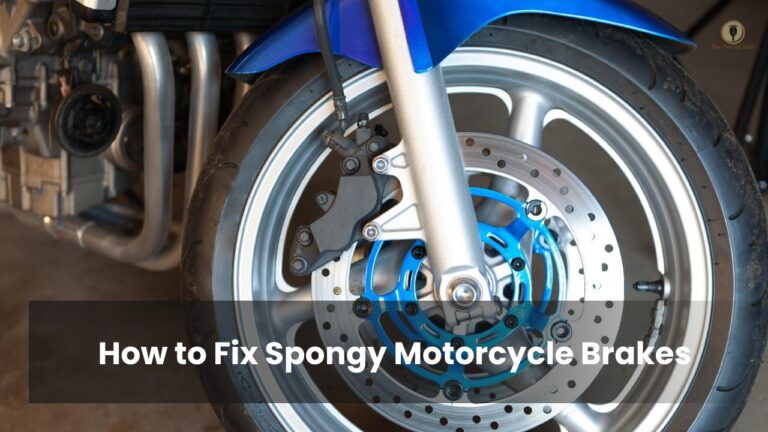Brake pads are a necessary safety component to any motorcycle, and maintaining them is an essential part of any vehicle maintenance.
However, brakes that give out undue pressure can lead to severe accidents, so you need to keep your brakes in top condition at all times.
The spongy brake is a common issue on motorcycles, and this article will provide a detailed guide for checking and fixing a spongy motorcycle brake.
Ensure that everything from the tire pressure and brake pads is up-to-date so that even one of these components isn’t wearing out too much before getting replaced.
Typically, spongy brakes occur when there’s air gets inside your bike brake line, which prevents brake fluid from flowing properly.
This is why it is vital to replace these parts if this is what’s going on with your bike because they will only worsen as time goes by.
It could also be caused by excess wear down of metal components within the brake assembly itself.
And finally, keep an eye out for large amounts of dust accumulating around the pedals while you’re riding, and make sure you have enough distance before stopping to avoid using the brakes.
What to Check if Your Motorcycle Brake is Spongy
1. Brake Fluids: make sure it’s not low or leaking. A low brake fluid causes the brake pad to wear off quickly and can also lead to a spongy brake.
If you’ve noticed a low brake fluid tank leaking from either end of your bike (brake reservoir or brake line), this may mean that the seals need to be replaced and fast.
2. Brake Pads: Brake pads also tend to deteriorate with time, and this will cause them to get spongy as well; ensure your motorcycle is regularly inspected for signs of deterioration in your vehicle’s brake system.
Make sure your brake pads haven’t worn off. Worn-off brake pins can be difficult to notice. Still, usually, there will be a noticeable squeaking noise when you apply the brakes, and they may also produce an uneven braking experience.
There are various brake pads in a motorcycle, such as the front brake pads and the rear brake pad. These brake pads can get spongy if not adequately cared for. For example, a spongy rear brake pad is a result of not cleaning the brake pad enough.
Suppose your motorcycle is approaching or has passed its service intervals for changing the front and rear brake pads (usually every two years). In that case, it’s time you replaced them before any damage occurs that could cause a spongy feeling in the pedal from metal-on-metal contact between the faulty parts.
3. Brake lines: It’s crucial to inspect the brake lines for leaks, kinks, or other damage that may cause a spongy feeling in the pedal. How to know a faulty brake line; the brake lines can become brittle and crack over time due to age, sun damage, or incorrect installation. When you apply the brakes, you may hear a hiss as air escapes from the leaky line – this is an indication that your bike needs new brake fluid ASAP!
4. Brake Rotor: The brake rotor is located very close to the brake pads, and as they wear down, the rotor can become spongy. You’ll have to confirm this by looking closely at your bike’s parts.
If you see any black material coming off of the rotors, that is a sure sign that it must be replaced soon or risk damaging other parts.
5. Cables and Shoes: the wires and shoes make contact with the brake pads, and if they are worn down, this may cause a spongy feeling.
Checking and Fix the Brake Fluids
Perform the following:
1. Brake Fluid Level
When you check your brake fluid levels, if it is below the minimum level, this will cause a spongy feeling when braking. It may also indicate other issues with the brakes and should be addressed as soon as possible.
2. Brake fluid change
Spongy brakes can usually be fixed by simply changing the brake fluid; however, it may require addressing other parts if you are dealing with a more severe issue.
If the brake fluid is old, there is a need for it to be replaced. If brake fluid becomes contaminated by water (or dirt), the brakes will become spongy, in addition to other problems such as loss of braking power or pedal pulsation.
How to Change Brake Fluid Process
Follow this process in changing your brake fluid from a motorcycle.
● Park your motorcycle on level ground and turn the engine off. You may want to place a block under one of the wheels so that it does not roll if you stop using it for any period while working with brake fluid.
● Locate the master cylinder, typically located in front of or below where the rider sits on their bike.
● Find an open space nearby to catch any spills or drips, and then loosen the hose clamp on one side of the master cylinder with a wrench.
● Now find some container such as a jar lid or milk jug top (a coffee mug would suffice in most cases) that can hold up to three cups of brake fluid when appropriately filled.
● Fill it about halfway up with new brake fluid using your funnel and carefully pour this into the open space in front of where these two lines are mounted onto each other without letting any spill.
● The next thing to do is put your bike onto the center stand and raise it on its front wheel so that you can look at the backside of where these two lines are mounted with each other.
● If any fluid is left over after removing it from its mount, make sure all traces have been entirely removed before screwing both ends into place using an Allen key.
● Then finally, make sure the brake lever with these two lines is functioning correctly by pulling on it and seeing if there’s a response.
● If there’s no response, that means air has found its way into the brake line, and there would be a need to bleed the brake lines.
Bleeding Brake Lines
The best way to fix a spongy brake on a motorcycle is by bleeding or purging old air bubbles from within the lines of your bike’s system.
This can only be done by using mechanical tools such as these two types of syringes – one for injecting new oil into the line and another to extract any remaining fluids to refill them again with fresh fluid.
Brake Fluid Specification
The brake fluid is designed to dissipate heat from the braking system while also preventing air bubbles and moisture within the lines.
There are different brake fluids available in the market, and it is vital to know the type of brake fluid needed for your motorcycle and what brand.
However, to know the brand that suits your brake system, check the “DOT” specification that is always pasted on the master cylinder of your motorcycle.
Also, if you have previously used a DOT 5 brake fluid and want to change it to a new DOT specification, it is important to remove the old brake fluid.
Never add another brake fluid brand with another brand because brake fluids contain compound chemicals such as lubricants and corrosion inhibitors.
3. Checking and Fix Brake Pads
When checking brake pads, it is essential to determine if they require replacement or just a simple adjustment. In case you decide on the latter, use this guide.
-Replacing Brakes: One way to fix a spongy motorcycle brake and make them work like new again is by replacing them with newer ones that have stiffer springs; however, there might be other reasons for your broken brakes than just worn out spring tension, so please consult an expert before making such decision.
Air Compressor – A Quick Fix? Sometimes people will try using air compressors to fix their bike’s braking system, and rightfully so since compressed air can take up some space within a fluid line and purge any remaining moisture preventing wear. So compressing air into the deflated areas can solve the problem.
4. Checking and Fix Brake Lines
Whether you’re just checking them for air bubbles or replacing them altogether, first remove any dust/debris from the lines by blowing into each end before the beginning.
Next, check all four brake line ends (front and rear) to attach to the caliper. Make sure there are no kinks or obstructions that could cause binding when you apply pressure.
If your brake line has a screw fitting, tighten it with an Allen wrench until snug, and don’t forget about any other bolts on those lines as well.
If they’re too tight, unscrew them just enough so there is still some tension without damaging the rubber seals/O-rings inside the fittings, but air will continue entering through that opening and create, if not tightened down properly more spongy brakes.
Replacing Brake Lines: It may be time for new brake lines if yours are cracked or frayed in places where they bend around corners (example – lower control arm).
5. Checking and Fix Brake Rotors
Brake rotors are essential in a brake system.
If there’s a lot of rust or corrosion, clean it up with brake cleaner and then sand off the paint/coating.
Doing this will expose any cracks in the metal, so you know whether to replace them now or later on down the road when they’re even worse.
Effects of Heat on Brake Rotors
The heat from heavy braking can warp brake rotors, causing vibrations when the brakes are applied.
6. Checking and Fix Braided Steel Lines
– Braided steel lines can be cut if they’re too short
– Replace with a longer line, or add an extension pipe to make it long enough
7. Checking and Fix Cables and Shoes
– Replace any frayed or broken cables, as they will continue to degrade over time.
– Dry out your shoes periodically by sprinkling them with brake cleaner and then wiping it off
Summary
Following this guideline will make your brakes feel better and save you money on the brake job.
If you’re still having problems with a spongy brake after following these steps, contact your local certified motorcycle mechanic!
This article tackles how to stop a spongy motorcycle brake when feeling like there’s no stopping power behind it.
Sponginess can be caused by many different things, from corrosion buildup and cracked metal to heat warping rotors and broken cables. Each of which is detailed in this article.
The easiest way to fix any problem is usually prevention, so using regular maintenance as described in the guide below should prevent most issues before they happen.
To avoid having braking problems in the future with your bike, make sure you regularly inspect – especially before long trips where the brakes may be used more than usual.


